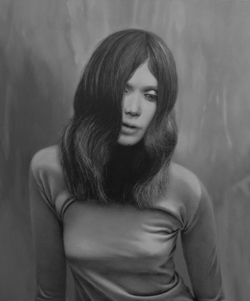

 Born in 1979 in Tokyo, Japan. Lives and works in Tokyo.
Born in 1979 in Tokyo, Japan. Lives and works in Tokyo.
Taguchi Kazuna lays invisible layers under the glossy surface of her photographic works. She first collects a variety of close-at-hand visual images from magazines, newspapers and the internet, and then uses them to make a series of photo collage. For example, she cuts out the eyes, nose and mouth of female models from various fashion magazines or advertisements and puts them together to create a fictitious person. Next, she uses the collage to depict a super-realistic monochrome painting in black and white acrylic. As a last step, she takes a picture of the painting and makes a print. The photograph is her final product, which is then exhibited in front of us.
In this way, Taguchi creates a new image culled piecemeal from the overflowing world of publishing and then embarks on a process of reproduction by collaging, painting and photographing in which she copies the surface of each through a variety of different media. Photography is a technique that captures the real world just as it looks. Painting is a form of expression that is used to depict an individual subjectivity. Obsessed with the reproduction of images, she explores the boundaries of photography and painting and makes the entire realm of artistic expression ambiguous.
In her series Stars of 2005, Taguchi employs pictures of the cosmos that she found on the internet as a base. A dim shadow appears on the surface of each photograph, which is in fact Taguchi’s own silhouette, captured as she took pictures of her paintings while blocking the lighting from different angles to achieve this effect. She indirectly inserts a trace of her presence onto images originally transmitted through the mass media. In the flood of excessive images in our contemporary society, we appreciate them as real. Taguchi manually reproduces those images and reverses the position of originality and reproduction. Copying images produces subtle differences and equations. From these accidental errors, non-fictional and fictional elements become mingled in her works. In so doing, she creates a portrait that is real but still ambiguous and peculiar. Her work possesses quality of emptiness even though it is fully informed by our media-obsessed environment.